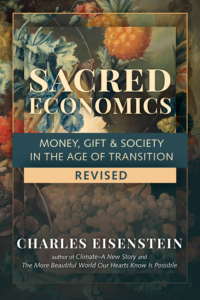Climate — A New Story
Chapters
Chapter 5: Carbon: The Ecosystems View
The Cult of Quantity
Carbon accountancy has a certain appeal to my inner math geek. I would love to approach the problem of climate change rationally, with familiar cognitive tools. I would divide Earth into various biomes and use the research to estimate the average carbon sequestration level per hectare for each of them. Multiplying by the total number of hectares, I would add up the contribution of each biome to determine a global carbon budget. I would calculate how much of various greenhouse gases we could continue releasing without exceeding the biosphere’s absorptive capacity, and therefore how quickly we need to cut fossil fuels, how many trees we need to plant, how many kelp forests, and so on. Each policy option would come with a number. Adding capacity here, subtracting it there, offsetting a strip mine in one place with a new forest somewhere else, we could make rational, climate-friendly decisions.
I hope the image of the smart guy shuffling numbers around the globe as if playing a board game is at least a little unsettling. As the foregoing descriptions of forests show, nature does not consist of a multitude of discrete, independent bits. When we chop nature up into bits in an attempt to understand it, we lose sight of the relationships among those bits. But ecological healing is all about the healing of relationships.
The arithmetic implied by carbon sequestration figures suggests that we can abstract natural and social processes from their context. When we compartmentalize and reduce and denominate natural processes in terms of carbon, what gets left out are the relationships among them. We are in the habit of calling various processes “factors” that contribute to climate change or climate health, but the very concept of a factor is already a problem. One multiplies factors together to obtain a product; change one factor, and the product changes predictably as well. Factors are how we reduce a number to a bunch of smaller, simpler numbers. But complex systems do not resolve easily into independent factors that we can address piecemeal. Our very approach to problem-solving becomes an obstacle to solving the problem.
It isn’t only forests whose living complexity far exceeds our ability to measure, quantify, and reduce to data. What number should we give the climate contribution of sea otters? They don’t sequester carbon—but they keep down populations of sea urchins, which when unchecked destroy kelp forests that do absorb carbon and alkalize seawater, allowing shellfish to absorb even more carbon.
What number would we give to the climate contribution of coastal fish? The decimation of commercial coastal fisheries has generated population explosions of snails and crabs, which then devastate salt marshes, which sequester carbon. Some biologists suggest that the decline of seaweed and seagrass can be traced to hundreds of years of overfishing, which predates current stressors of coastal ecosystems.[23] Collapsed trophic relationships leave ecosystems more vulnerable to eutrophication and other disturbances. One result is a shift in dominance from seagrasses and long-lived seaweeds to oxygen-choking algae blooms and, consequently, less carbon sequestration. Fish also help buffer acidity by excreting large amounts of calcium carbonate in their feces. According to the 2015 Living Blue Planet Report, the ocean fish population has declined by half since the 1970s.[24] Other research puts the decline in total fish biomass at two-thirds over the last century.[25] Increased acidity weakens corals and shellfish, sending ripples of disturbance through the ocean ecosystem. The health of one impacts the health of all.
And what about the whales? I remember when I was a child during the heyday of the environmental movement, when environmentalism transcended political identity and the phrase “Save the whales” was not yet a derisive cliché. Today, saving the whales is one of those environmental issues that the climate change crusade has marginalized. It seems a sentimental afterthought in the context of stopping climate catastrophe.
When I began researching this topic, I knew that whales must be crucial for the well-being of the planet, an intuition for which I could offer no evidence. How could saving the whales possibly affect greenhouse gases or any other global parameter?
It turns out that my intuition was well founded. First, an important means of removing carbon from the air is through marine ecosystems, the most productive of which are where cold, nutrient-rich deep water wells up to the surface. The nutrients allow kelp and plankton to grow, supporting an entire food chain and cycling carbon into the deep ocean. Today, there are fewer and fewer sites of upwelling deep water, and as a result, growing expanses of “marine desert” nearly devoid of life. This is ordinarily attributed to warmer surface water; an alternative hypothesis (or at least a contributing factor) might involve the decimation of whale populations, which are at a small fraction of pre-whaling levels.[26] Whales bring nutrients up from beneath the thermocline and deposit them near the surface in their feces. That might explain why krill populations have fallen in Antarctic waters where the whales that feed on the krill have been decimated. One would think the krill would flourish once their main predators were gone, but it is the opposite.
Whales also transport nutrients laterally. Many whales, especially blue whales, grow fat in the polar regions before swimming to the tropics to give birth and nurse their young. Conditioned by a geomechanical paradigm, one would think that biological nutrient transport would be insignificant in the vastness of the oceans, but careful research suggests otherwise. I especially recommend the paper “Global Nutrient Transport in a World of Giants,”[27] which documents the role of megafauna in distributing nitrogen, phosphorus, and other nutrients, both within the ocean and onto land. (This is significant in the carbon frame because phosphorus and nitrogen are key limiting parameters on the biotic uptake of carbon.) The paper notes that 150 mammalian megafauna have gone extinct since the Pleistocene, resulting in precipitous drops in nutrient transport across continents and oceans. Whale populations have declined by up to 99 percent for some species (such as blue whales), and lateral diffusion capacity for nutrients has declined by 98 percent in the Southern Ocean, 90 percent in the North Pacific, and 86 percent in the North Atlantic. Without the whales, it is no wonder that the ocean deserts are spreading. The scenario on land is equally grim, also due to megafauna depletion: lateral nutrient diffusion has fallen by at least 95 percent in every continent besides Africa.
Furthermore, whales and other ocean organisms merely by swimming around contribute enormous amounts of kinetic energy to the oceans, which according to some estimates equals the contribution of winds and tides to the mixing of ocean layers.[28] Not only does this bring nutrients to the surface, but it might contribute to the cooling of the upper layers. The steep decline of the whales, and more recently the fish due to industrial overfishing, could easily contribute to warming of the surface layers of the ocean even if the oceans’ total heat content remained the same.
Another avenue by which whales might affect greenhouse gas levels is through ecological trophic cascades—chain reactions that reverberate through an ecosystem. According to one hypothesis, the massive decline in whale populations following the post–World War II whaling boom, which drove many species to the brink of extinction, deprived orcas of their main food source.[29] So they turned to smaller prey, including seals, sea lions, and otters. They so decimated the otters that the otters’ prey, sea urchins, exploded in population and destroyed kelp forests. Kelp forests in turn are important in sequestering carbon and mitigating ocean acidity. Excessive acidity prevents shellfish and coral from growing, removing another carbon sink.
I hope these examples illuminate the impossibility of encompassing the biosphere within quantitative models, and the impossibility of healing the biosphere with policies derived from those models. I hope they also make it clear that the climate is not something separate from the biosphere in which plants and animals live; rather, the climate is an aspect of the biosphere, much more intricately connected to life than science had thought. Therefore, if we are to inhabit a climate suitable for life, we must serve the flourishing of life in all its forms.
Carbon accountancy contributes to the supposition that we can maintain a healthy biosphere by analyzing the carbon contribution of each of its constituents, possibly sacrificing those that have little contribution and cultivating those that have a lot. This mindset makes no sense from a living planet approach. The carbon accountant cannot measure how whale, forest, or wetlands conservation will impact atmospheric CO2, much less subtler variables like endocrine-disrupting chemicals in the water or microwave radiation in the air. Thus these receive scant attention at the climate policy table.
In order to value what measurements and models leave out, we need another basis upon which to make our choices. It is the living planet paradigm, based on the Story of Interbeing that says that the health of all depends on the health of each.
As the research cited in this chapter shows, quantitative science can serve the living planet paradigm, elucidating the connections among all beings. However, we can no longer hope to steer policy by quantifying the greenhouse impact of one choice versus another. Such calculations are fraught with peril, because they depend on the accuracy and extent of our knowledge. Species or systems once thought to have little relevance to climate turn out to be crucial. It was only in the 1990s that the role of mycorrhizae in carbon sequestration began to be appreciated. It was only in 2009 that researchers confirmed that fish excrete calcium carbonate.[30] It was only in the 2000s that it became known that boreal forests promote low-altitude cloud formation.[31] The megafauna nutrient transport paper was published in 2016. If we’d accounted for these things using the science of a decade ago, their carbon credit score would have been zero.
Until recently, both boreal and mid-latitude forests in climate models were shown to contribute more to warming than to cooling.[32] Imagine the effects of a “science-based” policy that drew from those models. Imagine you are a timber or mining company executive trying to justify the destruction of a forest for profit. Maybe you have a conscience. You really want logging to be okay, and here is a reason.
Indeed, the lumber industry is fond of saying that forestry products are helping fight climate change, because the trees that are cut down end up as building materials that don’t return carbon to the atmosphere for hundreds of years; meanwhile, the trees that grow to replace them take additional CO2 out of the atmosphere. If that’s all you measure—the embodied carbon in wood—the argument is sound. But it leaves out the hard-to-measure soil carbon, erosion, hydrological effects, biodiversity effects, and so on.
Our models and metrics will inevitably be faulty, sometimes underestimating and sometimes overestimating the climate effects of various natural and human activities. In a metrics-based policy environment, developers and polluters will seize on these discrepancies whenever they coincide with their economic interests. Wielding the numbers, their arguments will glow with the sheen of science.
While it might seem to us that, from a climate view, a mangrove is more important than a temperate forest, or a coral reef more important than a mountainside, or a wolf more important than a bluebird, we have to remember the limits to our knowledge. Carbon arithmetic will always leave something out.
What else have we left out? I suspect that the scientific lens has excluded far more than this chapter has suggested. Whales’ contribution to nutrient cycling is already hard to measure—what about the role of their songs in maintaining a pan-oceanic neural network? What about the role of elephant migration patterns in maintaining the subtle energetic pathways of Earth’s ley lines? Surely it would disqualify me from serious conversations on climate if I were to take this opportunity to bring in the cetacean mind, dolphin psychic communication, and the teachings of animal whisperers, plant spirit dreamers, dowsers, shamans, etc., who purport to bring messages of relevance to planetary healing. To the numbers guy, these seem a fatuous distraction from the practical matters at hand. But the knowledge and the methods of the numbers guy are failing us, and another worldview is knocking at the door. I believe that ultimately, planetary healing will require engaging sources of knowledge and ways of knowing far beyond what we accept today.
Even considering only mundane ecological science, the last two chapters have made it clear that unless we bring the excluded, devalued, and marginalized back in, climate change will continue to worsen even if we succeed in drastically reducing fossil fuel use. It might be warming, it might be cooling, it might be intensifying fluctuations, a derangement of normal, life-supporting rhythms. Then will we realize the importance of those things that we’d relegated to low priority: the mangrove swamps, the deep aquifers, the sacred sites, the biodiversity hotspots, the virgin forests, the elephants, the whales—all the beings that, in mysterious ways invisible to our numbers, maintain the balance of our living planet. Then perhaps we will realize that as we do to any part of nature, so, inescapably, we do to ourselves.
End Notes
[23] Schellnhuber (2004), 259.
[24] World Wildlife Federation (2015), 7.
[25] Christensen et al. (2014).
[26] See, for example, Roman and Palumbi (2003).
[27] Doughty et al. (2016).
[28] Dewar et al. (2006).
[29] Whitfield (2003).
[30] Kwok (2009).
[31] Spracklen et al. (2008).
[32] Bonan (2008).






